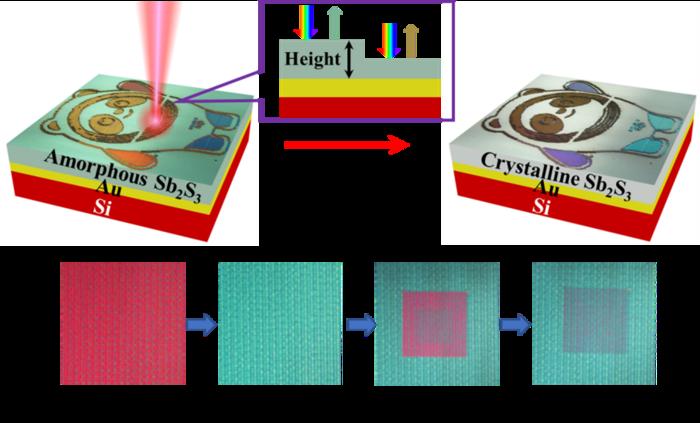A new publication from Opto-Electronic Advances, 10.29026/oea.2024.230033 discusses non-volatile dynamically switchable color display via chalcogenide stepwise cavity resonators.

Credit: OEA
A new publication from Opto-Electronic Advances, 10.29026/oea.2024.230033 discusses non-volatile dynamically switchable color display via chalcogenide stepwise cavity resonators.
In the field of color display technology, the traditional color display technology uses dyes, pigments and other color absorbing materials for spectral filtering and color development, which has problems such as low lifetime, fading, not environmental-friendly, color crosstalk, etc., causing color absorbing materials to face greater challenges in high-resolution display, imaging and other applications. Compared with the traditional color development technology, the color generated by the structure, structural color, such as rainbow and soap bubble, peacock feather and butterfly wing, etc., has the characteristics of higher brightness, smaller size, fastness, environmental-friendly, and has great advantages in color display, imaging technology and anti-counterfeiting technology. With the development of nano-manufacturing technology, artificial nanostructures such as metamaterials and metasurfaces with high-degree of freedom spectral regulation provide a new technical means for the field of structural color. However, most of the researches on the structural color mainly focus on the design of geometric features such as the size, shape and period of the unit cell. Based on physical mechanisms such as plasmon resonance, a variety of colors are generated by changing the design. Once the design is determined, the color cannot be dynamically changed. Structural colors with dynamic control ability have become an important development direction. At present, the display technology based on the dynamic adjustable optical parameters such as liquid crystal molecules has shown the ability to dynamically control the structural color, but it has the problems of volatile color, high energy consumption and slow response, which greatly limit its application. Therefore, how to achieve non-volatile, fast, dynamic display is still a challenge. Herein, it is reported that a Non-volatile fast dynamically switchable color display by incorporating chalcogenide within an asymmetric stepwise pixelated cavity array.
The research group of Prof. Tun Cao from Dalian University of Technology, together with the research group of Prof. Minghui Hong from Xiamen University, has proposed a non-volatile dynamic display technology based on the stepwise resonance cavity of chalcogenide. They have experimentally realized a lithography-free dynamically switchable color reflector by incorporating chalcogenide within an asymmetric stepwise pixelated Fabry–Pérot (FP) cavity array. More explicitly, the femtosecond (fs) laser has been employed to fabricate the asymmetric FP cavity array consisting of the stepwise chalcogenide film sandwiched by a 100 nm thick gold reflector and air. They have demonstrated that the height of the chalcogenide film cavity can be engineered by modulating the power of fs laser irradiation. These pixelated FP cavities with various cavity height (namely the thickness of chalcogenide film) can produce a robust, vivid color palette owing to the interaction of the light in the multilayered structure. The reflectance can be continuously tuned over the whole visible spectrum by engineering the thickness of the chalcogenide layer within the cavity. Based on unique non-volatile and reversible properties of phase transition in chalcogenide, the chalcogenide is used as the active dielectric to dynamically modulate the reflected color by transiting the state of chalcogenide with fs laser pulses. They have presented a dynamic color microprint ‘Bing Dwen Dwen’ illustrating the possibility of making arbitrary dynamic microprints. Moreover, their color reflector does not need any complex lithographic techniques during the fabrication, which significantly reduces the complexity and device cost. These color-varying devices based on the chalcogenide phase change materials may pave the path toward the next generation of inkless erasable papers or displays and offer camouflaging surfaces, compact systems, and signaling to engineer the spectrum of visible light.
Keywords: tunable / color displays / Fabry-Pérot cavity resonators / color printing / chalcogenide materials
# # # # # #
Tun Cao is a professor and dean in School of Optoelectronics Engineering and Instrumentation Science, Dalian University of Technology, China. He is the Director of Laboratory of Advanced Micro-Nano photonics Technologies and Applications. His research fields include active photonics and plasmonics, optical mechanics, optical materials evolutionary design, laser fabrication, and nonlinear optics. He has published more than 150 scientific papers and 50 patents. He is also contributing as editorial board member of high-impact journals.
# # # # # #
Opto-Electronic Advances (OEA) is a high-impact, open access, peer reviewed monthly SCI journal with an impact factor of 8.933 (Journal Citation Reports for IF2021). Since its launch in March 2018, OEA has been indexed in SCI, EI, DOAJ, Scopus, CA and ICI databases over the time and expanded its Editorial Board to 36 members from 17 countries and regions (average h-index 49).
The journal is published by The Institute of Optics and Electronics, Chinese Academy of Sciences, aiming at providing a platform for researchers, academicians, professionals, practitioners, and students to impart and share knowledge in the form of high quality empirical and theoretical research papers covering the topics of optics, photonics and optoelectronics.
# # # # # #
More information: http://www.oejournal.org/oea
Editorial Board: http://www.oejournal.org/oea/editorialboard/list
All issues available in the online archive (http://www.oejournal.org/oea/archive).
Submissions to OEA may be made using ScholarOne (https://mc03.manuscriptcentral.com/oea).
ISSN: 2096-4579
CN: 51-1781/TN
Contact Us: [email protected]
Twitter: @OptoElectronAdv (https://twitter.com/OptoElectronAdv?lang=en)
WeChat: OE_Journal
# # # # # #
Article reference: Liu K, Lin ZY, Han B et al. Non-volatile dynamically switchable color display via chalcogenide stepwise cavity resonators. Opto-Electron Adv 7, 230033 (2024). doi: 10.29026/oea.2024.230033
Journal
Opto-Electronic Advances
DOI
10.29026/oea.2024.230033




